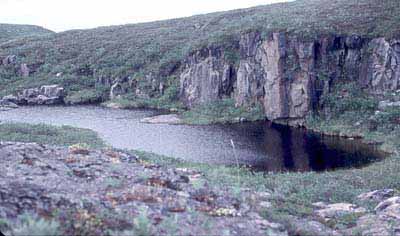Bloody Falls National Historic Site of Canada
Kugluktuk, Nunavut

General view
© Agence Parcs Canada / Parks Canada Agency
Address :
Kugluk/Bloody Falls Territorial Park, Kugluktuk, Nunavut
Recognition Statute:
Historic Sites and Monuments Act (R.S.C., 1985, c. H-4)
Designation Date:
1978-06-19
Event, Person, Organization:
-
Thule
(Organization)
-
Pre-Dorset
(Organization)
Other Name(s):
-
Bloody Falls
(Designation Name)
Research Report Number:
1978-SUA, 2009-CED-SDC-046, 2009-CED-SDC-049
Description of Historic Place
Bloody Falls National Historic Site of Canada is located within Kugluk / Bloody Falls Territorial Park, on the western shore of the Coppermine River, in Nunavut. The site encompasses pre-contact Aboriginal encampments set on river terraces along the broad, swift-flowing river. These encampments, of which there are no extant remains, were used as Aboriginal hunting and fishing stations for over three millennia, dating to 1700 B.C.E. Official recognition refers to the section of Kugluk / Bloody Falls Territorial Park that falls to the northwest of the Coppermine River.
Heritage Value
Bloody Falls was designated as a national historic site of Canada in 1978 because: it was a traditional fishing site, also containing small caribou hunting stations, that record the presence of Pre-Dorset, Thule, First Nation and Inuit cultures over the past three millennia.
The archaeological remains found at Bloody Falls represent the occupations of several Aboriginal and Inuit peoples, spanning thousands of years. Material deposits were documented from the Thule occupation period circa. (1000-1500 B.C.E.). Beneath the bottom-most Thule layer of cultural deposits, Pre-Dorset (also referred to as the Arctic Small Tool Tradition) cultural material was discovered, dating from between 1700 and 1500 B.C.E. The location, away from the coast in the interior, served as a staging area for forays to hunt, fish and to obtain native copper.
In addition to the Thule houses, 10 pre-contact and historic Aboriginal encampments were recorded to the northern end of the site. These encampments yielded stone and bone artifacts from the pre-contact period, dating to 160 C.E. Also documented at the site were materials relating to the early historic occupation of Copper Inuit.
Sources: Historic Sites and Monuments Board of Canada, Minutes, 1978, 2009.
Character-Defining Elements
Key elements that contribute to the heritage character of the site include: its location in the Kugluk / Bloody Falls Territorial Park, in Nunavut; its setting on river terraces along the western banks of the Coppermine River; the integrity of any surviving or as yet unidentified archaeological remains from Pre-Dorset, Thule, First Nation, and Inuit cultures found within the site, including cultural material, faunal remains and any vestiges from pre-contact occupation; viewscapes across the Coppermine River.